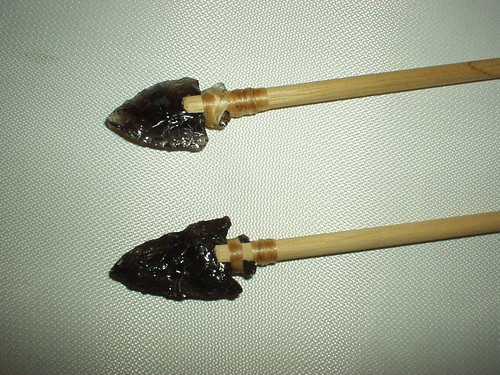Hi me etc
Well thanks for the genuine interest. I'll post a couple of photos and tell ya more. <img src="/forums/images/graemlins/wink.gif" alt="" />
First off if you want to make a scallop shell spoon, make a dedicated handle for it and tie it to a stick thats been ground down to the right shape with a flat spot aganst the back of the shell. Its easiest to drill and carve shell with a dremel, but don't breath the dust. There is artificial (yellow rough nylon) sinew on the market. I use it to tie my arrowheads and feathers to arrow shafts. (I cheat and use 1/4" dowls) <img src="/forums/images/graemlins/ooo.gif" alt="" />

This photo shows 3 flakes and a practice piece. The lower right flake is from triflow - 3 colored obsidian. This shows just how thinly obsidian can split. Surgeons use obsidian knifes for some delicat operations. The brown mahogany obsidian is a "spall" a larger flake that can become a tool. It has a huge flake removed from the top side making it very thin and ready to become a spear head. The lower left is a "youth practice piece" found in Nevada. It has flakes over its entire surface yet it never turned into anything useful.

In this image I am showing how thin the mahogany spall is. When I stepped on the cord and pulled it taught, I only had to run about an inch of unsharpened blade (in its historic condition after being found on the ground) with moderate pressure and the cord cut cleanly.

Here is an old hand woven Navajo rug, my deerskin quiver full of arrows and an arrow on the blanket.

Some old arrowheads and 2 spear heads. At the top is an obsidian needle, which come is all sizes. and on the top left is a hole puch "awl" make from an arrowhead. A good piece of rock can be many tools as it becomes broken and reduced. An axe can become 5 arrowheads that become 10 bird points and an awl. Making an awl is way difficult and it is made from a broken arrowhead.

Heres is my pipestone 4 winds pipe, a ground hatchet head from central Illinois, a spall on the left, and a scraper of shale from the north west territories.

this photo shows how the arrow is notched for the arrowhead and tied in. Pine pitch might also have been used. The necklace is a real Jivarro head hunter piece woven with seed pods. Sometimes I wear it.

2 more arrowheads on arrows

and finally this is my Kachina Eagle Dancer that I bought in New Mexico in August.
I met a Cree Indian in Nevada who took us home to his museum house. He showed us all of his toys and taught me to flake rock. Thank you Wild Bill. There are books on the subject and you can mail order heat treated preshaped arrowheadds that work easily.
WARNING
Stone flakes are sharper than razors. Use atleast 2 layers of THICK belt leather between your hands and the piece. Wear leather gloves and safety goggles. Do not breath the dust. Be satisfied at first with bird points as its about all you'll be able to get. I takes a lot of practice to make the flake the size you want and to make it run in the direction you choose. The next hard thing is learn to knotch it so it can be tied to an arrow.
Jim <img src="/forums/images/graemlins/laugh.gif" alt="" />
P.S. be prepared to get a condition called "arrowhead shoulder", an intense pain in the neck from pushing so hard while pressure flaking. Modern people just are not tough enough to go around breaking rocks all day.

















 Previous Topic
Previous Topic Index
Index








